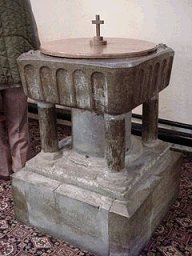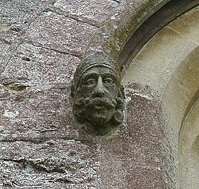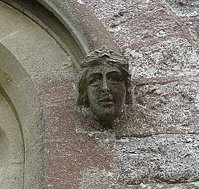T
| In 1829
the Old Church was in a bad state of repair, so it was decided to draw up plans
for a new Church, as the population of the parish was 620 and the Old Church
could only accommodate 200. As efforts to obtain a piece of land in a more
central position in the parish failed, it was decided to accept the piece of
land near the Old Church, kindly given by Sir G. I. Tapps. One estimate was for
£1,003 using materials from the Old Church as well as new stone. The
buttresses were to be of stone from the Old Church, as were also the jambs and
arches of the doors. |
| ~ Inside the little Church ~ |
| The floor of the Chancel, the steps, vestry and Bone
House were to be laid with the stone of the Old Church. The stone and earth
tiles of the roof were also to be used in the New Church roof. Unfortunately,
an estimate for £1,160 for building the Church in all new materials was
accepted, and for £100 rebate, the builder was given permission to take
down the Old Church and dispose of the materials, but not before the New Church
was finished and used for Divine Worship. |
 |
| The foundation stone for the New Church was laid on
18th July 1833, by the second Earl of Malmesbury. It was consecrated and opened
for Worship on 9th November 1834, by the Bishop of Winchester, being dedicated
to St. John the Evangelist. The seating accommodation was for 472 persons. At
this time, of finishing and furnishing the New Church, the Font met with a
strange adventure, instead of being brought from the Old Church to the New, it
was accidentally carted away and lost, until discovered some years later in a
garden at Verno, between Hinton Admiral and Christchurch. It was brought back
to Holdenhurst and restored to its rightful position. |
| There is hanging in the present church a copy of a
drawing by Cecilia Montgomery dated 1839, entitled "The New Church of
Holdenhurst and the old Saxon Chapel, before it was demolished". Until St.
Peters Church Bournemouth was build in 1845 and its parish carved out of that
of Holdenhurst, this Village Church was the Parish Church of Bournemouth and
Divine Service was performed twice on Sundays to packed congregations. When
first built, the new Holdenhurst Church was without Chancel and West Porch.
These were built at the expense of Rev. F. Hopkins in 1872. |
| ~ Four of the Stained Glass Windows ~
|
| The tessellations of the reredos came from the Mount of
Olives, the mosaics from San Sophia, Constantinople and from Rome. The West
window in the Church depicts Moses lifting up a bronze serpent, and a tablet
under the window explains that parishioners gave it as a token of gratitude to
the Rev. Hopkins for building the chancel and porch. On either side of the
centre window are two more modern ones. The one on the left side was given by
Robert Birley (one time headmaster of Eton) in memory of his father Leonard
Birley, who was a regular worshipper in this church. It depicts "The sower
went forth to sow" and in the background are two houses standing at the
far end of the village green. The window on the right which depicts the
"Reaper", with Holdenhurst Church in the background was given in
memory of Joseph and Edith Copper-Dean, of Littledown, the parents of Miss
Ellen Copper-Dean and the late Miss Edith Cooper-Dean. Holdenhurst Church
ceased to be annexed to Christchurch in 1808, becoming a perpetual curacy, and
in 1875 it was constituted a vicarage, and the Rev. Frederick Hopkins became
the first Vicar. |
|
 |
|
 |
|
| There are two Carved Stone Faces |
| to found at the rear of the Church
|
| The Rev. Hopkins resigned in 1903 having been in charge
of Holdenhurst for over 50 years. The organ was installed as a memorial to him,
subscribed for by parishioners and visitors with a grant from the Carnegie
Corporation of New York in 1913. |
|

